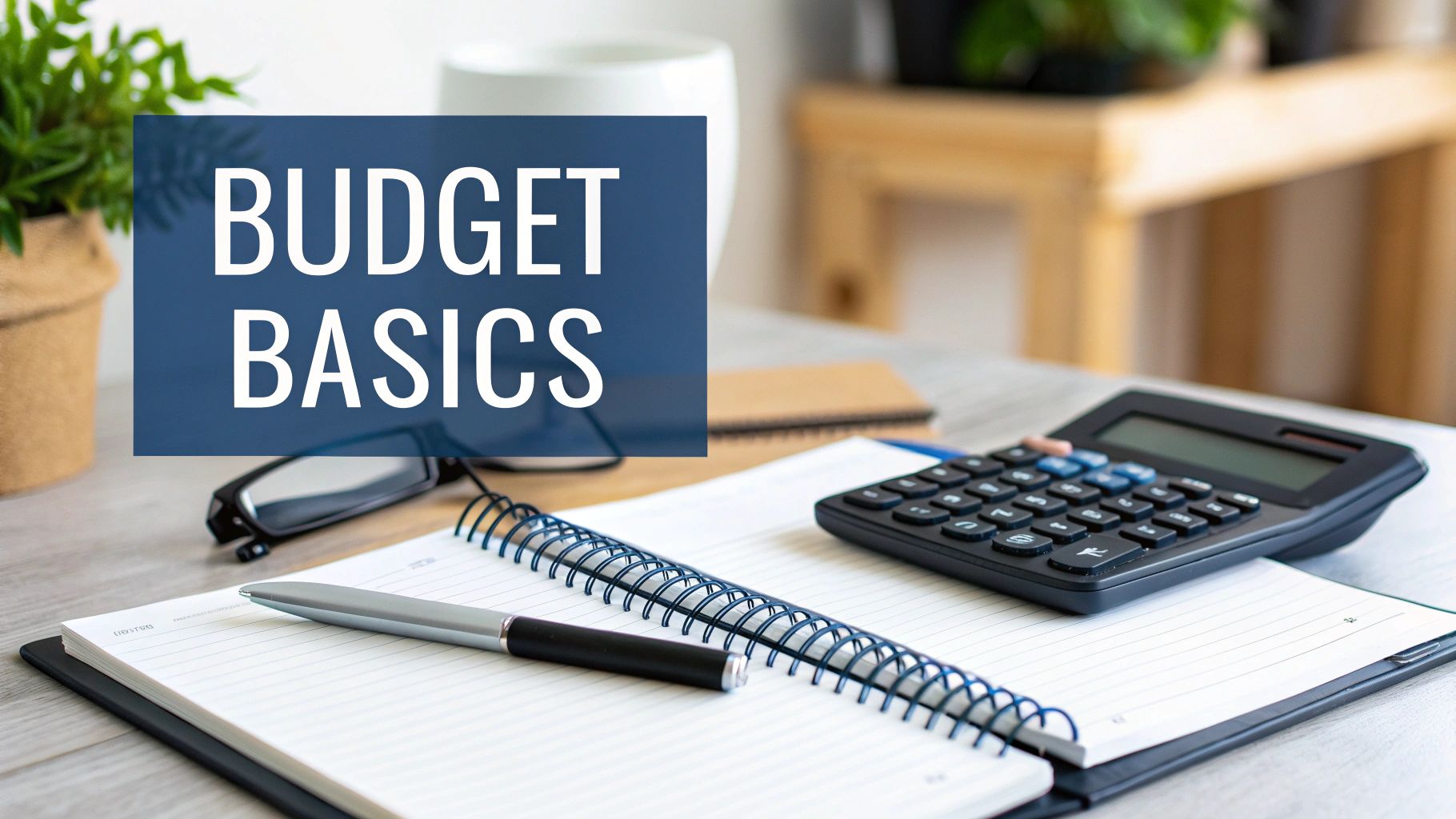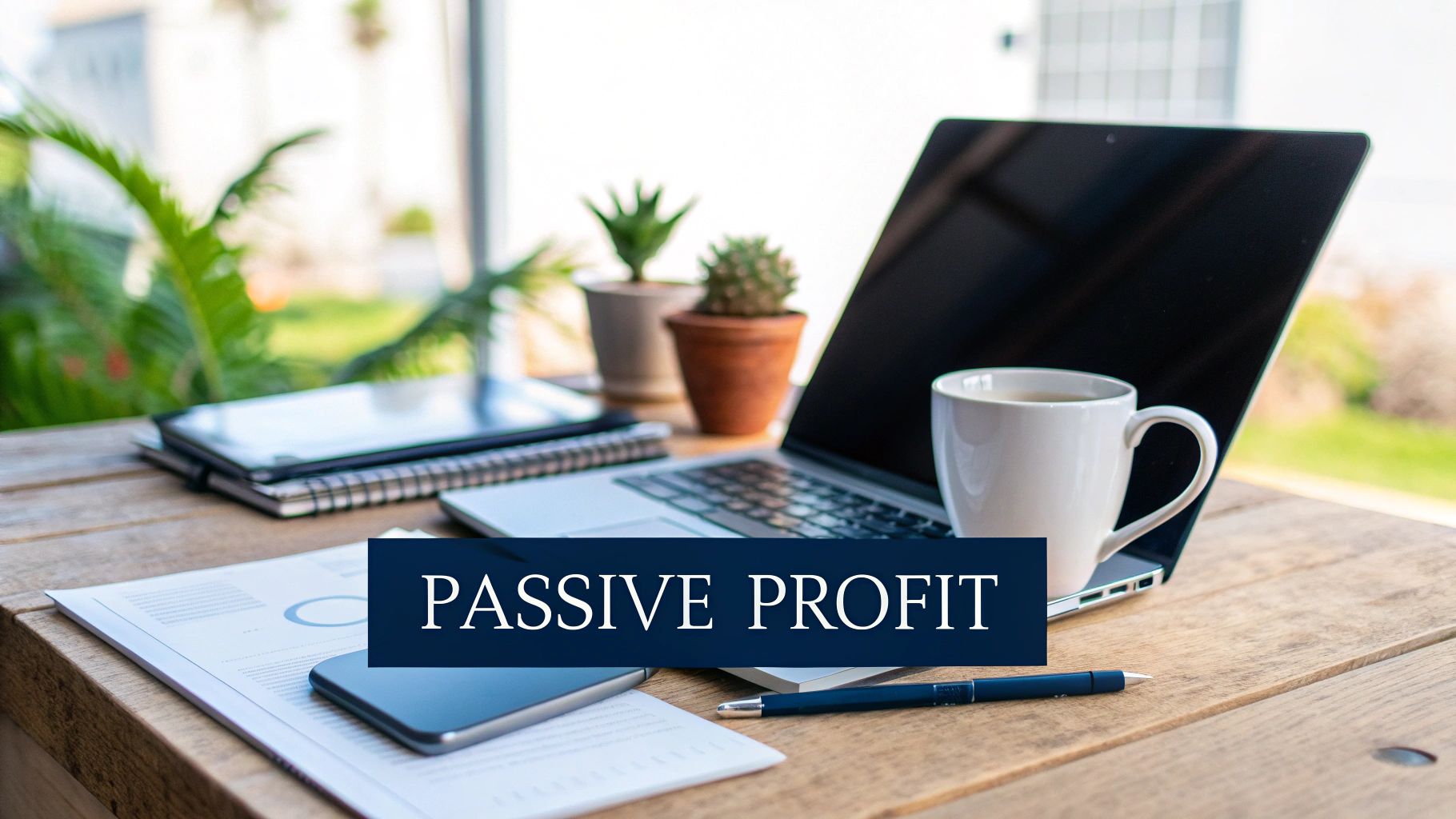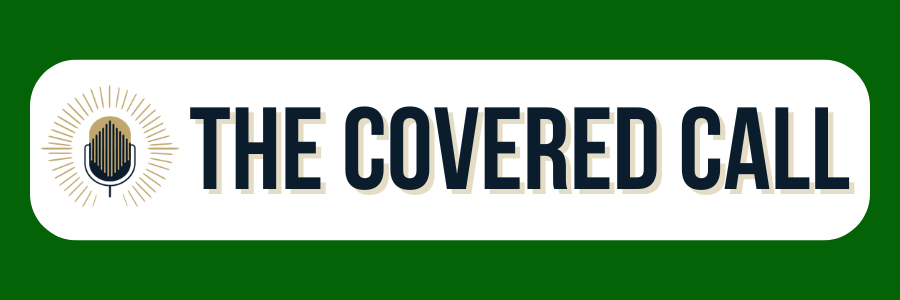Understanding True Financial Freedom

Financial freedom. For many, it brings to mind images of relaxing on a beach, retiring early, or pursuing a dream career. But true financial freedom goes beyond just having a large bank account. It's about having control and choices in your life. It's about not feeling trapped in a job you dislike purely because of financial obligations.
Defining Financial Independence
Financial freedom begins with financial independence. This is the stage where your passive income—earnings from sources other than your primary job—covers all your expenses. This income could come from investments, real estate, or other assets. Financial independence isn't about being wealthy, necessarily. It's about generating enough income to support the lifestyle you want. For some, that may mean living simply. For others, it could involve a higher standard of living. The crucial element is aligning your income and expenses.
The shift from relying on active income (trading your time for money) to passive income (letting your money work for you) is key. This transition allows you to make decisions based on your values and priorities, rather than being restricted by financial limitations. This might mean more time with family, pursuing a creative project, or the ability to decline opportunities that don't align with your goals.
Stages of Financial Freedom
The path to financial freedom is a personal journey with several distinct stages, each representing a different level of financial security.
Financial Security: This is the foundation. You can reliably meet your basic needs—housing, food, and transportation. You have a consistent income and manage your expenses without the constant stress of just making ends meet.
Financial Stability: Here, you've established an emergency fund and are actively working to pay down debt. You feel more in control of your finances and less vulnerable to unexpected financial challenges.
Financial Independence: Your passive income now completely covers your living expenses. You're no longer dependent on a traditional job for income and can pursue other endeavors.
Financial Abundance: This final stage is marked by substantial wealth exceeding what's needed for expenses. You have the resources to invest significantly, engage in philanthropy, or leave a legacy.
Financial freedom is closely linked to overall financial well-being. Data from the Consumer Financial Protection Bureau shows that between 2017 and 2020, Americans saw an average rise in financial well-being, largely due to government pandemic responses. However, roughly one-third of U.S. adults reported a decline during this period. Understanding your current place on this spectrum is vital for creating a personalized plan to achieve financial freedom. Each stage demands different strategies and a distinct mindset. Recognizing your current position is the first step toward future financial growth.
Mapping Your Financial Starting Point
Before charting a course to financial freedom, it's essential to understand where you stand financially. This begins with a thorough self-assessment to establish a realistic baseline. It's not about judging past choices, but about gaining clarity to inform future decisions.
Assessing Your Net Worth
The first step is calculating your net worth. This is simply your assets (what you own) minus your liabilities (what you owe). Assets might include cash, investments, or the value of your home. Liabilities include debts such as mortgages, student loans, and credit card balances. Honesty is key during this process; use actual market values for your assets. This honest assessment builds a solid foundation.
Tracking Income and Expenses
Next, track your income and spending. Understanding your cash flow—where your money comes from and where it goes—is essential for improvement. Consider your primary income sources: your salary, side hustles, or other income streams. Then, categorize your expenses: housing, transportation, food, and entertainment. This detailed tracking provides valuable insights.
Evaluating Debt Obligations
Honestly evaluate your debts. Consider the types of debt you hold and their interest rates. High-interest debt, like credit card debt, can significantly hinder progress toward financial freedom. Prioritizing high-interest debt repayment is a crucial step. This frees up more income for saving and investing. For example, aggressively paying down a 20% interest rate credit card balance can offer greater returns than many investments.
Organizing Financial Information
Staying organized is key to avoiding feeling overwhelmed. Use tools like spreadsheets, budgeting apps like Mint, or even a simple notebook to track everything. Many digital tools can automate this process. An organized approach provides clarity and empowers informed decisions, meaning less time worrying and more time focusing on growth. Successful individuals consistently monitor their finances. They understand awareness, not obsession, is key. Regular check-ins, perhaps monthly or quarterly, maintain focus and motivation without getting bogged down. These check-ins are chances to adjust strategy, celebrate progress, and stay motivated on the path to financial freedom.
To help guide your self-assessment, use the checklist below:
Financial Freedom Assessment Checklist A comprehensive checklist to evaluate your current financial position
| Assessment Area | Key Questions | Action Steps |
|---|---|---|
| Net Worth | What are your total assets (cash, investments, property)? What are your total liabilities (mortgages, loans, credit card debt)? | Calculate your net worth (Assets - Liabilities). Update this calculation regularly. |
| Income & Expenses | What is your total monthly income from all sources? What are your essential and non-essential monthly expenses? | Track your income and expenses meticulously. Identify areas for potential savings. |
| Debt Obligations | What types of debt do you have (mortgage, student loans, credit cards)? What are the interest rates on each debt? | Prioritize paying down high-interest debts. Explore debt consolidation options if applicable. |
| Financial Organization | Where do you keep your financial records? How often do you review your financial situation? | Organize your financial information using spreadsheets, budgeting apps, or other tools. Schedule regular (monthly/quarterly) financial check-ins. |
This checklist provides a starting point for taking control of your finances and working toward financial freedom. Remember, consistent effort and informed decisions are key to achieving your goals.
Crafting Your Financial Freedom Blueprint
Generic financial advice often misses the mark because it doesn't consider individual situations and goals. Building a personalized roadmap to financial freedom begins with a crystal-clear understanding of your current financial standing and your aspirations. This means setting motivating financial milestones, figuring out your personal financial freedom number, and identifying the key checkpoints on your journey.
Defining Your Financial Freedom Number
Your financial freedom number represents the total amount of money you need invested to create enough passive income to cover all your expenses. This number is unique to everyone and depends entirely on their desired lifestyle. For instance, someone dreaming of international travel will have a very different financial freedom number than someone happy with a simple life in a small town.
To calculate your financial freedom number, first, determine your annual expenses. Then, factor in your anticipated safe withdrawal rate, which is the percentage you can withdraw annually from your investments without depleting the principal. A common safe withdrawal rate is 4%. Divide your annual expenses by your chosen safe withdrawal rate to arrive at your financial freedom number.
Setting Meaningful Milestones
The path to financial freedom can feel daunting without clearly defined, attainable milestones. Break down your overall goal into smaller, manageable steps. Instead of focusing exclusively on the final number, celebrate the wins along the way.
Some examples of milestones could include:
- Paying off a specific debt
- Reaching a certain savings target
- Generating a particular amount of passive income
These smaller victories boost motivation and reinforce positive progress, making the larger goal feel less overwhelming. Think of it like running a marathon – you focus on the next mile marker, not just the finish line. This approach helps you gain momentum and keep a positive mindset.
Exploring Multiple Pathways to Freedom
There isn't a single "right" way to achieve financial freedom. Several different paths can lead to the same destination. Some people achieve financial independence through traditional employment paired with aggressive saving and investing. Others find success through entrepreneurship, real estate investment, or building a diverse investment portfolio.
Connecting with people who have achieved financial independence through various avenues can provide valuable insights and help you identify the best strategy for your unique situation. Understanding the broader economic environment also plays a role. In the United States, the financial freedom index, tracked by The Heritage Foundation, has historically ranged from 70 to 90 points since 1995. The latest value in 2024 was 80 points, suggesting a relatively high level of banking efficiency and independence from government control. This index considers factors like government regulation of financial services and the development of financial markets. Learn more about the financial freedom index here.

Aligning Your Plan With Your Values
Ultimately, make sure your financial freedom plan aligns with your core values. Financial freedom is more than just accumulating wealth; it's about designing a life that truly resonates with you. Ask yourself what genuinely matters. Is it having more quality time with loved ones, pursuing a passion project, or supporting a cause you believe in?
By clarifying your values, you can build a financial plan that supports the life you want, not someone else's version of success. This means integrating your financial goals with your broader life goals for lasting satisfaction.
Income Acceleration Strategies That Actually Work
Achieving financial freedom quickly often hinges on accelerating your income. This isn't about endless overtime, but about working smarter. It's about strategically creating multiple income streams. Let's explore some proven strategies to boost your earning power.
Leveraging Existing Skills for Side Hustles
Many of us have valuable skills we can use to generate extra income. Think about your strengths. Could your writing skills land you freelance gigs? Perhaps your design talent could be used for graphic design projects. Side hustles let you earn more without upending your current lifestyle.
They're also a great way to test the waters of entrepreneurship while bringing in extra cash to invest or pay down debt. This is a crucial step toward financial independence.
Negotiating for Higher Compensation
Knowing how to negotiate is key to maximizing your earnings in your main job. Research typical salaries in your field using resources like Salary.com or Glassdoor. Then, confidently present your value to your employer.
This isn't about being aggressive. It's about clearly demonstrating your contributions and how they benefit the company. A well-executed negotiation can lead to a substantial raise, significantly accelerating your journey to financial freedom.
Strategic Career Pivots
Sometimes, the best way to boost your income is to change careers entirely. Look for industries or roles with high growth potential and above-average salaries. This might mean learning new skills through online courses or certifications on platforms like Coursera or Udemy.
It takes time and effort, but moving to a higher-paying field can drastically shorten the time it takes to achieve financial freedom. This proactive approach sets you up for long-term financial success.
Entrepreneurial Ventures With Scaling Potential
Entrepreneurship offers huge income potential, especially with scalable business models. Service-based businesses, for example, can be launched with minimal investment and scaled by hiring more staff. Digital products offer another avenue for passive income, as they can be sold repeatedly without significant overhead.
Financial freedom often involves a combination of financial literacy, strategic investing, and capitalizing on economic opportunities. Platforms like Amazon FBA have helped many entrepreneurs achieve remarkable financial gains. Some report tripling their previous salary within a year by focusing on private label products. This highlights the potential of e-commerce and strategic business planning. Learn more about Amazon FBA and other e-commerce strategies here. These entrepreneurial paths offer flexibility and control over your income growth.
Maintaining Work-Life Balance
While increasing your income is important, so is maintaining a healthy work-life balance. Burnout can derail your long-term goals. Effectively managing your time and energy is essential for sustained progress toward financial freedom.
This means setting realistic goals, prioritizing tasks, and making time for rest and recovery. This balanced approach ensures your pursuit of financial freedom is sustainable and enjoyable, not a constant source of stress. By thoughtfully incorporating these income acceleration strategies, you can significantly boost your progress toward financial freedom without sacrificing your well-being.
Building Wealth Through Strategic Investments

Building a solid financial foundation involves more than just saving. It requires a strategic approach to investing, turning saved capital into a wealth-generating engine. This exploration delves into smart investing and how it can create passive income streams while growing your assets.
Understanding Investment Vehicles
The first step in strategic investing is understanding the available investment vehicles. These range from lower-risk options like index funds to more complex investments such as real estate or business ownership. Index funds offer a simple way to diversify investments across a broad market, reducing risk and providing steady growth. For example, an S&P 500 index fund tracks the performance of 500 of the largest publicly traded U.S. companies.
Dividend-generating stocks offer another avenue for passive income. These stocks represent companies that distribute profits to shareholders. This income can be reinvested for accelerated wealth growth.
Real estate, including traditional property ownership and Real Estate Investment Trusts (REITs), presents additional wealth-building opportunities. Traditional real estate generates passive income through rental payments. REITs allow for real estate investment without direct property management responsibilities.
Finally, owning a business can be a highly effective, though demanding, wealth-building strategy. It requires planning, dedication, and risk tolerance.
Before we delve further into investment strategies, let's compare some key investment vehicles to help you understand the potential returns, risks, and time commitment associated with each. The following table provides a concise overview:
Investment Vehicles Comparison
| Investment Type | Potential Return | Risk Level | Liquidity | Time Commitment |
|---|---|---|---|---|
| Index Funds | Moderate | Low to Moderate | High | Low |
| Dividend Stocks | Moderate | Low to Moderate | High | Low to Moderate |
| Real Estate | Moderate to High | Moderate to High | Low | Moderate to High |
| REITs | Moderate | Moderate | Moderate | Low |
| Business Ownership | High | High | Low | High |
This table highlights the trade-offs between different investment options. For example, while business ownership offers high potential returns, it also comes with high risk and a significant time commitment. Index funds, on the other hand, offer a more balanced approach with moderate returns and lower risk.
Key Investment Concepts
Several key concepts are crucial for building wealth through investments. Dollar-cost averaging involves investing a fixed amount regularly, regardless of market conditions. This minimizes the impact of market volatility.
Asset allocation, distributing investments across different asset classes, is another vital component. Your allocation should align with your age, risk tolerance, and financial goals. Younger investors often allocate more to growth-oriented investments.
Compound growth is the concept of earning returns on your initial investment and accumulated interest. This effect can significantly accelerate wealth creation.
Starting Small and Scaling Up
You don't need a fortune to start investing. Small, consistent contributions can grow substantially due to compound growth. As your resources expand, you can increase your portfolio. Leveraging tax-advantaged accounts like 401(k)s and Roth IRAs offers significant tax benefits.
Achieving financial freedom often requires innovative strategies and entrepreneurship. Ezine publishing, for instance, has been a lucrative business model, allowing income generation through advertising and subscriptions. By leveraging email marketing, a growing industry, entrepreneurs can build a loyal customer base and create income streams. Learn more about these strategies here. This example highlights the importance of adapting to trends and using online platforms. By understanding investment principles and choosing suitable vehicles, you can build a powerful engine for wealth creation, driving you toward lasting financial freedom.
Daily Habits of the Financially Free
Financial freedom isn't about a sudden windfall. It's the result of consistent daily habits that gradually build a solid base for financial independence. These habits aren't about self-denial, but rather mindful choices and automated systems that support your long-term objectives.
Budgeting That Works in Real Life
Effective budgeting isn't about restricting your spending. It's about understanding where your money goes and making sure your spending aligns with what's important to you. Many people have found success with budgeting systems like the 50/30/20 rule. This involves allocating 50% of your income to necessities, 30% to wants, and 20% to savings and debt repayment.
Others prefer zero-based budgeting, where every single dollar has a designated purpose. The key is to find a system that fits your lifestyle and stick with it. This consistent awareness is the foundation of a strong financial base.
Automating Your Wealth-Building
Automation is key for financial freedom. Set up automatic transfers to your savings and investment accounts. This "pay yourself first" approach ensures consistent progress, even when life gets hectic. Automating bill payments helps avoid late fees and helps maintain a positive credit history. Think of these automated systems as your financial autopilot, guiding you toward your goals.
Mindful Spending and Resisting Lifestyle Inflation
Mindful spending means making intentional choices about what you buy. Ask yourself if a purchase truly reflects your values and contributes to your long-term goals. As your income increases, resist the urge to inflate your lifestyle. This common pitfall can seriously hinder your progress toward financial freedom.
Instead, put any extra income toward investments and paying down debt. This disciplined approach accelerates your journey to financial independence.
Continuous Learning and an Abundance Mindset
Financially free individuals consistently seek to improve their financial literacy. They read books, listen to podcasts like The Covered Call Podcast, and participate in seminars. This continuous learning empowers them to make well-informed financial decisions.
They also cultivate an abundance mindset, believing in opportunities and focusing on possibilities. This positive perspective reinforces their financial habits and fosters further success. Just as crucial, they strive for balance between financial pursuits and overall well-being, avoiding an unhealthy fixation on money. This balanced approach ensures a sustainable and fulfilling journey to financial freedom.
Maintaining Financial Discipline During Challenges
Life inevitably presents unexpected challenges. Job loss, unforeseen expenses, and market fluctuations can test even the most financially disciplined. Financially free people develop coping mechanisms for these difficulties.
They maintain emergency funds to handle unexpected events and adjust their spending as needed, keeping their focus on the long term. This resilience allows them to maintain progress even in tough times. They also understand that setbacks are temporary bumps in the road, not a reason to abandon their financial goals.
Protecting Your Financial Freedom

Building wealth is a major step toward financial freedom. But protecting your earnings is just as important. Even the best-laid plans can be derailed by unexpected events. This section explores key risk management strategies to help safeguard your progress and build resilience into your financial foundation.
Strategic Insurance Coverage
Insurance is a basic tool for protecting your financial freedom. It acts like a safety net, lessening the financial blow of unexpected events. Different types of insurance cover specific risks.
Health Insurance: This protects you from overwhelming medical expenses. Even a relatively minor illness or injury can result in significant bills.
Life Insurance: This provides financial support to your dependents if you die. It's especially important if you have a family that relies on your income.
Disability Insurance: This replaces part of your income if you can't work due to illness or injury. It's often overlooked, but it's critical for protecting your earning ability.
Property Insurance: This protects your physical assets, like your home or car, from damage or loss. It safeguards your investments from unexpected disasters.
Adequate insurance coverage offers peace of mind, knowing you’re prepared for life's curveballs. This lets you focus on building wealth, not worrying about potential problems.
Emergency Fund Planning
An emergency fund is a vital part of any financial plan. It's easily accessible cash reserved for unexpected costs, like job loss, medical bills, or home repairs. A good rule of thumb is to have 3-6 months of living expenses saved.
This financial cushion keeps you from dipping into investments or racking up high-interest debt during emergencies, preserving your long-term wealth-building plans.
Legal Protections for Assets
As your wealth grows, protecting it from potential legal issues becomes increasingly important. This could involve setting up legal structures like trusts or Limited Liability Companies (LLCs) to shield your assets from lawsuits or creditors.
Talking to a legal professional can help you figure out the right legal protections for your situation. This proactive step protects your hard-earned money.
Tax Optimization Strategies
Minimizing your tax burden is essential for maximizing your financial freedom. Tax-advantaged investment accounts like 401(k)s and Roth IRAs offer tax benefits that can significantly boost your progress. Understanding tax laws and using effective tax planning strategies helps you keep more of what you earn. This allows you to invest more, accelerating your path to financial freedom. Looking into available deductions and credits can further reduce your tax liability.
Estate Planning
Estate planning arranges for the distribution of your assets after your death. This involves making a will, naming beneficiaries for your accounts, and setting up trusts, if needed. Proper estate planning ensures your wealth is distributed according to your wishes and minimizes potential legal issues for your heirs. This protects your legacy and provides for your loved ones.
Avoiding Financial Pitfalls
The road to financial freedom has potential dangers. Some common traps include:
Scams and fraudulent investment schemes: Beware of opportunities promising unrealistic returns. Thoroughly research any investment before committing your funds.
Poor investment decisions: Diversification and understanding your risk tolerance are key to avoiding major investment losses. Seek professional advice if needed.
Overspending and lifestyle inflation: As your income increases, avoid the urge to increase your spending accordingly. Maintaining financial discipline is crucial.
Financial freedom is also affected by larger economic policies. The Index of Economic Freedom, published by The Heritage Foundation, measures economic freedom across multiple areas, including financial freedom and property rights. This index shows a connection between economic freedom and prosperity. Countries with higher scores often have more opportunities for financial independence. By understanding and avoiding these pitfalls, you can protect your financial future and stay on course toward your goals.
Achieving and maintaining financial freedom is a continuous journey. Using these protective strategies helps you create a solid financial base that can handle challenges and support your long-term goals.
Are you ready to take control of your financial future and explore less conventional paths to freedom? Listen to The Covered Call Podcast for inspiring stories, practical strategies, and expert advice from people who have successfully achieved financial and personal independence.

